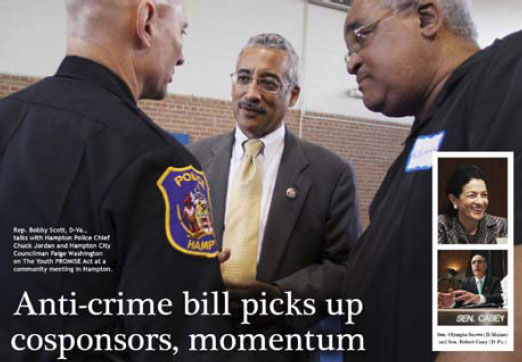Youth PROMISE Act
Latest News | Background Info | Resolutions | Press | Editorials | Endorsements | Briefing Materials
Fighting juvenile crime vs. “playing politics”
For too long, Congress has chosen to play politics by enacting so-called “tough on crime” slogans such as “three strikes and you’re out” or “you do the adult crime, you do the adult time”. As appealing as these policies may sound, the impacts of codifying these sound bites range from a negligible reduction in crime to an actual increase in crime.
The U.S. now has the highest average incarceration rate of any nation in the world, with the impact of this focus on slogan driven law  enforcement disproportionately falling on minorities, particularly Blacks and Hispanics. For Black boys being born in 2001, the Children’s Defense Fund (CDF) estimates that one in every three will end up incarcerated in their lifetime without appropriate intervention, a trajectory the CDF has described as a “cradle-to-prison pipeline.”
enforcement disproportionately falling on minorities, particularly Blacks and Hispanics. For Black boys being born in 2001, the Children’s Defense Fund (CDF) estimates that one in every three will end up incarcerated in their lifetime without appropriate intervention, a trajectory the CDF has described as a “cradle-to-prison pipeline.”
There is overwhelming evidence to show that it is entirely feasible to move children from a cradle to prison pipeline to a cradle to college, or jobs, pipeline. All the credible research shows that a continuum of evidenced-based prevention programs for youth identified as being at risk of involvement in delinquent behavior, and intervention for those already involved, will greatly reduce crime and save much more than they cost when compared to the avoided law enforcement and social welfare expenditures. And the research reveals that these programs are most effective when provided in the context of a coordinated, collaborative local strategy involving law enforcement and other local public and private entities working with children identified as at risk of involvement in the criminal justice system.
The PROMISE Model Fights Crime, Saves Money
Under the Youth PROMISE (Prison Reduction through Opportunities, Mentoring, Intervention, Support, and Education) Act (H.R. 2721), communities facing the greatest youth gang and crime challenges will be able to develop a comprehensive response to youth violence through a coordinated prevention and intervention response. Representatives from local law enforcement, the school system, court services, social services, health and mental health providers, foster care providers, other community and faith-based organizations will form a council to develop a comprehensive plan for implementing evidence-based prevention and intervention strategies. The plans can be funded up to four years. The act also enhances state and local law enforcement efforts regarding youth and gang violence.
Nothing in the Youth PROMISE Act eliminates any of the current tough on crime laws, and while it is understood that law enforcement will still continue to enforce those laws, research tells us that no matter how tough we are on the people we prosecute today, unless we are addressing the underlying root causes of criminal activity, nothing will change.
Aside from reducing crime and providing better results in the lives of our youth, many of the programs funded under the Youth PROMISE Act will save more money than they cost. The State of Pennsylvania implemented a process very similar to the one provided for in the Youth PROMISE Act in 100 communities across the state. The state found that it saved, on average, $5 for every $1 spent during the study period. The Richmond, Virginia Gang Reduction and Intervention Program (GRIP), a DOJ pilot program funded through a grant from the Office of Juvenile Justice and Delinquency Prevention, spent $2.5 million in a collaborative effort between the City of Richmond, federal, state and local partners focusing on a target community. In two years, major crimes in that target community were down 43% and homicides fell from 19 to two. Cities that receive grants under the Youth PROMISE Act will be required to track governmental cost savings that accompany a drop in crime, and recapture a portion of those savings to keep the PROMISE programs alive after the four year federal grant period ends.
Moving Forward
 In the 111th Congress, the Act attracted 235 co-sponsors in the House, including 19 Republicans. In the Senate, the Act was introduced by Sens. Casey (D-PA) and Snowe (R-ME) and attracted 15 co-sponsors. There is also a coalition of over 250 national, state and local organizations that support the act. This coalition also includes many cities and counties across the country that have passed resolutions in support of Youth PROMISE, including Los Angeles, CA, Pasadena, CA, San Francisco, CA, Santa Fe County, NM, New York, NY, East Cleveland, OH, Pittsburgh, PA, Norfolk, VA, Newport News, VA, and Hampton, VA. The US Conference of Mayors, at their 77th Annual Meeting in June 2009 adopted a resolution urging Congress to pass the Youth PROMISE Act. We continue to work to build momentum for the Act and to encourage members of the 112th Congress to support this bipartisan legislation by becoming a co-sponsor.
In the 111th Congress, the Act attracted 235 co-sponsors in the House, including 19 Republicans. In the Senate, the Act was introduced by Sens. Casey (D-PA) and Snowe (R-ME) and attracted 15 co-sponsors. There is also a coalition of over 250 national, state and local organizations that support the act. This coalition also includes many cities and counties across the country that have passed resolutions in support of Youth PROMISE, including Los Angeles, CA, Pasadena, CA, San Francisco, CA, Santa Fe County, NM, New York, NY, East Cleveland, OH, Pittsburgh, PA, Norfolk, VA, Newport News, VA, and Hampton, VA. The US Conference of Mayors, at their 77th Annual Meeting in June 2009 adopted a resolution urging Congress to pass the Youth PROMISE Act. We continue to work to build momentum for the Act and to encourage members of the 112th Congress to support this bipartisan legislation by becoming a co-sponsor.
The Youth PROMISE Act represents a paradigm shift in the way we address juvenile crime policy in America. Instead of doing what is politically expedient, we have the opportunity to both reduce crime and save money.
- 11.17.12 | Video: Rep. Scott Participates in a Panel, titled "Stop the Pipeline to Prison," at Metropolitan African American Methodist Episcopal Church in Washington, DC
- 10.01.12 | School Climate Matters Op-Ed: A Better Direction: Changing the Trajectory of At-Risk Youth
- 09.21.12 | Video: Rep. Scott Participates in a Panel on Addressing Youth Violence in Black America
- 07.25.12 | Interrupting the Violence
- 07.24.12 | Scott Focuses on Preventing Youth Violence in Several Events this Week on Capitol Hill
- 06.08.12 | Scott Works to Strengthen Workforce Investment Bill for Long-term Unemployed and Disadvantaged Youth
- Blog: Mandatory Minimum Sentences
- 04.02.12 | Scott Addresses National Forum on Youth Violence Prevention's Annual Summit
- 10.29.09 | Crime Subcommittee Holds Important Hearing on Racial Disparities in the Criminal Justice System
- 06.12.09 | Youth PROMISE Act Picks Up 150th Co-sponsor in House
- 05.14.09 | Youth PROMISE Act Picks Up 100th Co-sponsor in House
- 05.04.09 | Youth PROMISE Act Picks Up Endorsements in Advance of Advocacy Events on Capitol Hill
- 02.19.09 | Rep. Scott Visits Los Angeles to Promote Youth PROMISE Act
- 02.18.09 | Rep. Scott and Rep. Castle Introduce Youth PROMISE Act
- 12.03.08 | Youth Violence Summit - Empowering Communities to Combat Gang Crime: The Youth PROMISE Act
- 04.04.08 | Audio of Rep. Bobby Scott's and Sen. Joe Biden's briefing on "Reducing Violent Crime - International Perspectives"
- 02.26.08 | Audio of Rep. Scott's Media Roundtable on the Youth PROMISE Act
- Overview of the Youth PROMISE Act
- Rep. Scott's Press Release
- Dear Colleague Letter
- Text of the Youth PROMISE Act
- List of Cosponsors
- Letter from Organizations Supporting the Youth PROMISE Act
- Charts on Incarceration (Handout)
- National Juvenile Justice & Delinquency Prevention Coalition Letter Comparing Gang Bills Introduced in the 110th Congress
- Youth Law Center Letter Opposing H.R. 3547, the Gang Prevention, Intervention, and Suppression Act
- Human Rights Watch Letter Supporting H.R. 3846, the Youth PROMISE Act and Opposing H.R. 3547, the Gang Prevention, Intervention, and Suppression Act
- "Investing in Our Nation's Youth" - by Rep. Robert C. "Bobby" Scott - Congressional Black Caucus Foundation Spring 2008 Newsletter
Resolutions In Favor Juvenile Prevention and Intervention Practices
- U.S. Conference of Mayors, 77th Annual Meeting, Support for the Youth PROMISE Act
- U.S. Conference of Mayors, 76th Annual Meeting, Support for Cradle to Prison Pipeline Initiative (Sponsored by the President of the Conference of Mayors, Mayor Doug Palmer of Trenton, NJ)
- U.S. Conference of Mayors, 76th Annual Meeting, Comprehensive Gang Abatement Legislation (Sponsored by Mayor Sheila Dixon of Baltimore, MD)
- City of Los Angeles, CA
- City of San Francisco, CA
- Juvenile Probation Commission, City of San Fancisco, CA
- City of East Cleveland, OH
- City of Philadelphia, PA
- City of Pittsburgh, PA
- Santa Fe County, NM
- City of Norfolk, VA
- City of Hampton, VA
- City of Newport News, VA
- City of Pasadena, CA
- City of Richmond, VA
- City of Portsmouth, VA
- Annie E. Casey Foundation Report - No Place for Kids: The Case for Reducing Juvenile Incarceration
- Childrens Defense Fund: America's Cradle to Prison Pipeline Report
- Potential for Change: Public Attitudes and Policy Preferences for Juvenile Justice Systems Reform Center for Children's Law and Policy
- The Illinois Coalition for the Fair Sentencing of Children: Categorically Less Culpable - Children Sentenced to Life Without Possibility of Parole in Illinois
- Moving Toward A More Integrative Approach To Justice Reform - Open Society Institute
- The PEW Center on the States - One in 100: Behind Bars in America 2008
- Charles Hamilton Houston Institution for Race & Justice: No More Children Left Behind Bars
- And Justice for Some: Differential Treatment of Youth of Color in the Justice System - National Council on Crime and Delinquency
- American Psychological Association - Disseminating Evidence-Based Practice For Children and Adolescents
- The Impact of Substance Abuse on Federal, State and Local Budgets - National Center on Addiction and Substance Abuse at Columbia University
- The Annie E. Casey Foundation: No Place For Kids - The Case for Reducing Juvenile Incarceration
- 12.31.09| Try new approach with young offenders - The Virginian-Pilot
- 12.29.09| With prevention, intervention, and enforcement, reduce crime and violence one neighborhood at a time - The Daily Press
- 06.24.09 | Anti-crime bill picks up cosponsors, momentus - The Hill
- 05.21.09 | Is Suppression Enough? Congress takes a fresh approach to the gang issue - the truth - Loudoun Independent
- 09.12.08 | Turning Point in the Gang Crisis - The Nation
- 07.25.08 | Chicago: Murder rate sparks political spats - The Washington Times
- 07.16.08 | Youth Empowered to Find their Voice, Push for Better Future - The Christian Post
- 07.13.08 | Hard to tell real gangs from mere wannabes - The San Diego Union-Tribune
- 07.11.08 | In the inner city, a summer job can be a lifesaver - The Providence Journal (Providence, RI)
- 04.23.08 | Inmate Count in U.S. Dwarfs Other Nations' - The New York Times
- 03.28.08 | Congressman Bobby Scott Hosts "Teen Summit On Violence" In An Effort to Promote The Youth PROMISE Act - EdNews.org
- 03.25.08 | Congressman Bobby Scott hosts teen crime and violence summit - WAVY-TV10 - Hampton Roads
- 03.20.08 | Small Businesses Offer Alternatives to Gang Life - The New York Times
- 03.10.08 | Police Chief: District's anti-gang laws ineffective - DC Examiner
- 12.21.07 | Building Boom - Daily Press (Newport News, VA)
- 12.07.07 | Experts on youth violence: Intervene early or pay dearly later - CNN.com
- 11.20.07 | The Gang Bill - EbonyJet Article
- 09.22.07 | Gang Crimes Have Fallen in Fairfax - The Washington Post
- 05.24.09 | The Wrong Way to Fight Gang Crime - The Washington Post
- 05.05.09 | Baron Davis: Breaking the Cycle of Inner-City Gang Violence - The Huffington Post
- 03.01.09 | Obama and the Black Agenda - Ebony Magazine
- 12.30.08 | A Job or a Gang? - The New York Times
- 07.29.08 | Fight the Roots - Toronto Star Editorial
- 07.24.08 | Don't need cape to be a crusader - The Seattle Times
- 05.04.08 | Blocking the Transmission of Violence - The New York Times
- 04.15.08 | Two Separate Societies: One in Prison, One Not - The Washington Post
- 03.20.08 | Cutting the Prison Rate Safely - The Washington Post
- 03.10.08 | Prison Nation - New York Times Editorial
- 03.03.08 | Cold-blooded Costs - New Orleans City Business
- 02.29.08 | Prisons vs. Colleges - Inside Higher Ed
- 01.31.08 | Breaking the School-to-Prison Pipeline - AlterNet
- 11.28.07 | Prevent, or build - Roanoke Times Editorial (Roanoke, VA)
- 11.27.07 | Gangbuster - Daily Press Editorial (Newport News, VA)
- 11.15.07 | Congress must target roots of gangs - Pasadena Star News (Pasadena, CA)
- 10.30.07 | Rep. Scott's blueprint can save young people - Virginian-Pilot Editorial (Norfolk, VA)
- 10.15.07 | Think Prevention First - Baltimore Sun Editorial (Baltimore, MD)
- 07.19.07 | The Wrong Approach to Gangs - New York Times Editorial
- Campaign for Youth Justice
- Fight Crime: Invest in Kids
- National Juvenile Justice Network
- Children's Defense Fund
- National Association for the Advancement of Colored People
- Coalition for Juvenile Justice
- The Sentencing Project
- Voices for America's Children
- American Psychological Association
- American Bar Association
- National Association of Criminal Defense Lawyers
- African American Ministers in Action
- Charles Hamilton Houston Institute for Race & Justice
- Ohio Supports the Youth PROMISE Act
- California Supports the Youth PROMISE Act
- National Council of La Raza
- Michigan After-School Partnership
- Penal Reform International
- Justice Policy Institute
- Child Welfare League of America
- pre[k]now
- National PTA
- Maryland Department of Juvenile Services
- Democrats for Education Reform
- American Civil Liberties Union
- The Southeastern Tidewater Opportunity Project (STOP)
- California Public Defenders Association
- Richmond Peace Education Center
- Virginia Department of Juvenile Justice
- Virginia Governor Timothy M. Kaine
- Peace in the Hood
- National Council for Urban (Formations) Peace, Justice and Empowerment
- First Focus: Campaign for Children
- Key Points of the Youth PROMISE Act from The Cochrane Collaboration College for Policy at George Mason Univeristy
- The Cochrane Collaboration College for Policy at George Mason Univeristy Overview
- Cochrane Collaboration College for Policy at George Mason Univeristy Youth Violence and Intervention Strategies Presentation
- Cochrane Collaboration College for Policy at George Mason Univeristy One Pager on the Cost of Adolescent Firearm Injuries
- Cochrane Collaboration College for Policy at George Mason Univeristy Implications of the Youth PROMISE Act
July 24, 2012 Violence Prevention Briefing Materials
- Dr. Peter Scharf : Murder And Policy Drift, an Analysis of New Orleans Crime Policy
- Dr. Robert Zagar: Reduce Violence, Save Money, Save Lives















